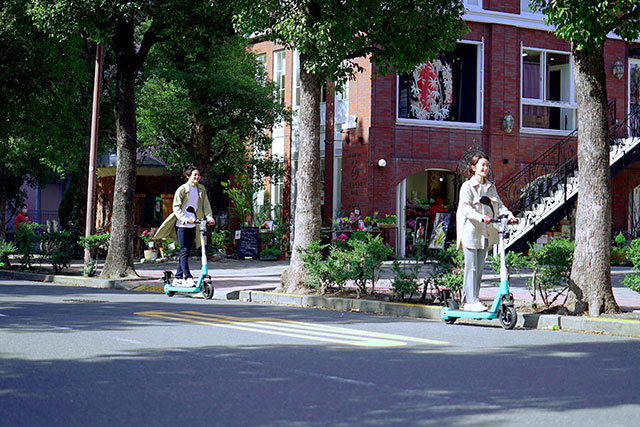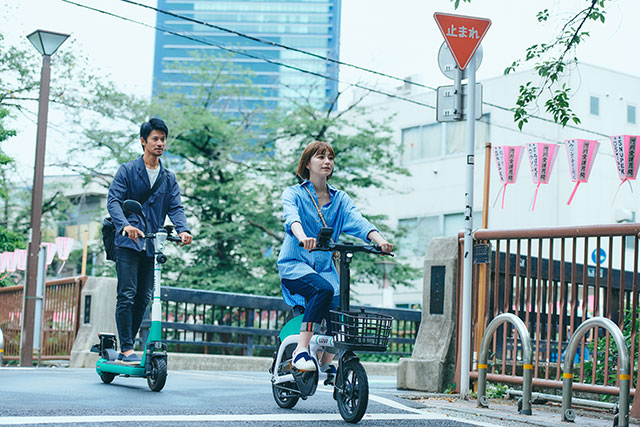
Tokyo has one of the best public transit systems in the world, whisking millions of commuters into and out of the capital every day, quickly, safely and usually on time. While it’s also the perfect way to explore the capital, you can get a totally different understanding of how the city fits together on a motorized kick scooter, a new way of getting around quickly and effortlessly.
-
01
Smoother rides
![Electric scooters, or kick-boards as they’re referred to are becoming an increasingly common site around Tokyo
Photo by Marat Mazitov on Unsplash]()
Electric scooters, or kick-boards as they’re referred to are becoming an increasingly common site around Tokyo Photo by Marat Mazitov on Unsplash
Partly because of its extensive train, subway and bus network and partly because of regulations, Tokyo is a latecomer to some forms of micromobility. Rental scooters, however, have begun popping up around hubs and residential neighborhoods over the past few years and it seems this trend will accelerate.
One reason is that in April 2022, the Japanese government revised the Road Traffic Law to make it easier to ride motorized scooters. Previously, these vehicles were categorized as mopeds and required a driver’s license and a helmet. But under the new rules, scooters that weigh less than 20 kilograms are classified as “specified small motorized bicycles.” That means they’re easier to ride legally on streets, and, under certain conditions, sidewalks.
The revisions are being phased in and will be complete by April 2024. From July 2023, if you are over 16 years old, you can ride scooters in Japan without a driver’s license or even a helmet, though they are strongly recommended.
According to a January 2023 National Police Agency statement, the revisions stipulate that scooters must be equipped with green lights in the front and back that must be illuminated while in use. Scooters that don’t have green lights will be treated like mopeds, which require helmets and a Japanese driver’s license, and are banned from sidewalks. However, enforcement of the green lights rules may only begin in December 2024, according to NHK.
Unlicensed users without helmets can ride scooters on roads and bike lanes at speeds up to 20 kilometers per hour. Those that do have helmets and driver’s licenses can cruise along at higher speeds but must, of course, respect traffic rules. The limit is 6 kilometers per hour for riding on sidewalks, during which time the green lights on scooters must be flashing.![Riding motorized scooters in Tokyo means obeying Japan’s traffic rules and laws, which includes sticking to the left side of the road]()
Riding motorized scooters in Tokyo means obeying Japan’s traffic rules and laws, which includes sticking to the left side of the road
There are a few other points to keep in mind when getting around by scooter. One is of course to obey Japan’s traffic rules, which means riding on the left side of roads, just as driving is on the left. Another is that license plates will still be required for motorized scooters. But these aren’t a problem when renting a scooter.
-
02
In the Luup
For visitors, renting a board in Japan can be a unique street-level travel experience. Pickup points, quickly proliferating, can be found at convenience stores and other nearby locations, eliminating the need to walk to a train or subway station. You can also return the scooter at a different pickup point, an option known as norisute in Japanese.
If you’re going to rent a board in Japan, chances are it will be from Luup. The Tokyo startup claims a market share over 90% for e-scooter rentals. It has a fleet of about 5,000 e-scooters and e-bikes parked at 2,340 pickup points in Tokyo, Kyoto and Osaka, from hubs like Tokyo Station to the famous Kinkakuji Temple to Family Mart “kombini” convenience stores.![Luup pickup points can be found all over the city, outside stores and even private residences.]()
Luup pickup points can be found all over the city, outside stores and even private residences.
Riding a Luup board is fairly simple, but you may need some Japanese skills. The app is only available in Japanese, as is the webpage detailing the fees (for e-scooters and e-bikes, there’s a basic ride fee of 50 yen plus 15 yen per minute, so a 30-minute ride is 500 yen; returning vehicles outside pickup points can result in other fees).
![Before you can use the Luup service you must install their app on your smartphone]()
Before you can use the Luup service you must install their app on your smartphone
Once you install the app, find a pickup point nearby, select either e-scooter or e-bike, scan the QR code on the handlebars and you’re off. Make sure to use winkers when turning and be careful of the many pedestrians, bikes and other vehicles in crowded urban areas. Once you arrive at your destination pickup point, take and upload a photo of your rental, and you’re done.
![Luup and other such services often have other modes of transport also available at their pickup points, like these power assisted bicycles.]()
Luup and other such services often have other modes of transport also available at their pickup points, like these power assisted bicycles.
Even though you don’t need a license, police can still fine you for disregarding traffic rules like stopping at red lights. So be sure to ride safely when you hit the road. That way, you’ll get the most out of exploring Japan’s cities on your board.











